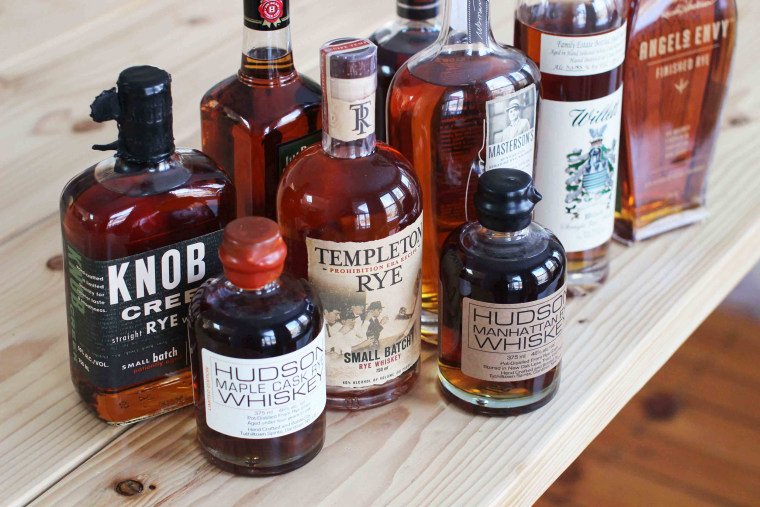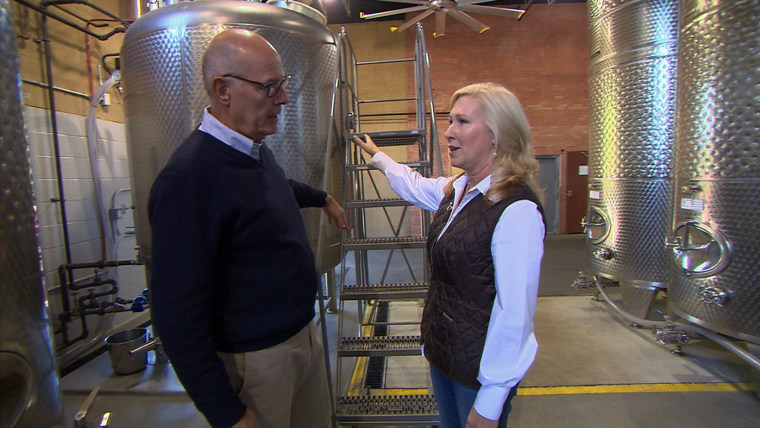As good as gone a few years ago, rye whiskey is back in a big way.
Sales of rye have increased sixfold, from slightly over $15 million in supplier revenues in 2009 to more than $106 million in 2014 (working out to about $300 million in retail sales), according to David Ozgo, chief economist of the Distilled Spirits Council (DISCUS). Those figures surpass even bourbon whiskey's well-documented boom.
“It's now a global phenomenon,” DISCUS Vice President Frank Coleman told NBC News. “Bartenders in London are crazy to get their hands on American rye.”
The boom is all the more impressive because rye whiskey, while wildly popular before Prohibition, nearly disappeared once the temperance movement flamed out.
Many whiskey enthusiasts say the spice inherent in a rye-based spirit is largely responsible for its resurgence.
“Rye is a gloriously spicy grain,” said Dave Pickerell, who left a longtime job as master distiller for Maker's Mark, a “wheated” bourbon, to make rye whiskey. “It's big and full bodied. It's what you want to graduate to if you're an American whiskey drinker.”
Emphasis on American.
“Rye whiskey should be America's historic spirit,” Pickerell continued. “When the colonists threw tea overboard it wasn't just tea that went; it was the British way of life, and that meant rum. That didn't mean they would quit drinking, thank God, it just meant no more rum.” With rye adapting well to the colonies' climate, “By 1810, there were thousands of rye distilleries all up and down the east coast. George Washington made rye whiskey at Mt. Vernon and made a good living at it.”

Pickerell continues the president's tradition today as master distiller at Mt. Vernon, which is producing rye whiskey again, as well as at Vermont's WhistlePig distillery. “It's no secret why I left Maker's Mark was to start WhistlePig,” he said. “I believed that rye was coming back.”
But why did it disappear?
Charles K. Cowdery, author of “Bourbon, Strange,” points to the popularity of lighter-flavored Canadian whiskey flowing in during Prohibition. “After Prohibition a lot of bourbons lightened up, but it was harder for rye,” he said.
Pickerell takes some credit for rye’s revival.
“We began doing doing annual press trips (to Mt. Vernon in 2001) to get press interested in George Washington and rye,” he said. As stories trickled out, rye began its uptick, he said.
It would take more, though. “I think it was bartenders that really drove it,” said Cowdery. As the craft cocktail movement gained steam, “because so many cocktails pre-Prohibition called for rye, they started making these vintage cocktails with rye. Even typical bourbon cocktails like the Manhattan can be made with rye and many people prefer them because rye cuts through the other flavors.”
Despite its dramatic growth, rye is still a small piece of the American whiskey market. Bourbon and Tennessee whiskey revenues hit $2.7 billion in 2014.
And not everyone is heralding rye's return.
“The growth can seem so enormous because you're starting from practically nothing,” Cowdery said. “Everybody wants to make a big deal about rye, but it's not that big a deal because it's just a variation on bourbon.”
Like its often mellower cousin bourbon, rye must be aged in new, charred oak vessels; the key difference is in the grain “mash bill.” A minimum of 51 percent rye is required in the makeup of rye whiskey, whereas bourbon must contain 51 percent corn.
With both whiskeys bearing the signature of their charred oak barrel, they're similar enough that Cowdery suggested many new fans of American whiskey can't discern the difference and are merely drinking what the bartenders make for them.
“American whiskey is up and a lot of people drinking it (are new) and I don't know that they necessarily know there are two different styles in that universe,” he said.
And bartenders keep pouring rye. As its popularity continues to soar, is demand in danger of outpacing supply? The distilled spirits council’s Coleman doesn’t think so, noting that more than 100 brands are on the market now and more are on the way. Several Kentucky bourbon makers are adding rye to their lineup, and craft distillers are popping up across the country.
Or could rye fever cool the bourbon boom? Pickerell doesn't think so. “Whiskey is exploding,” he said. “So it's not about carving the pie. It's about making more pie.”
